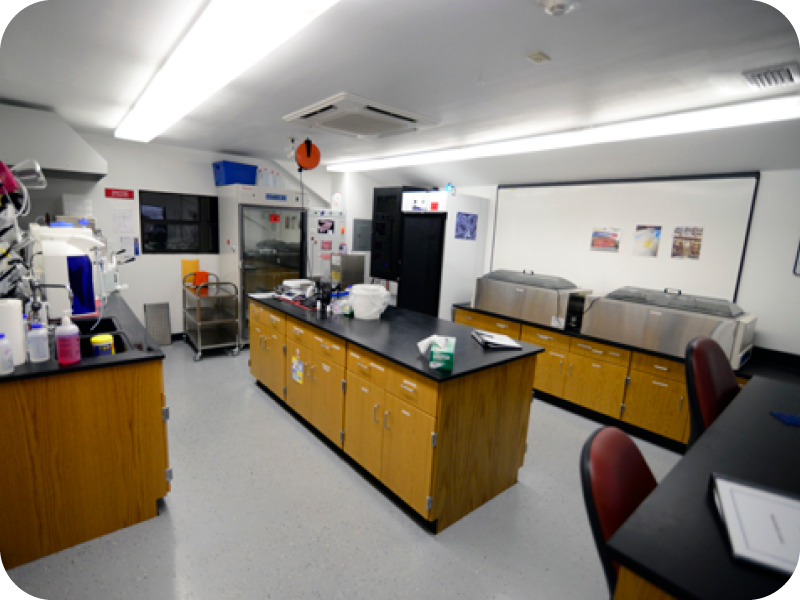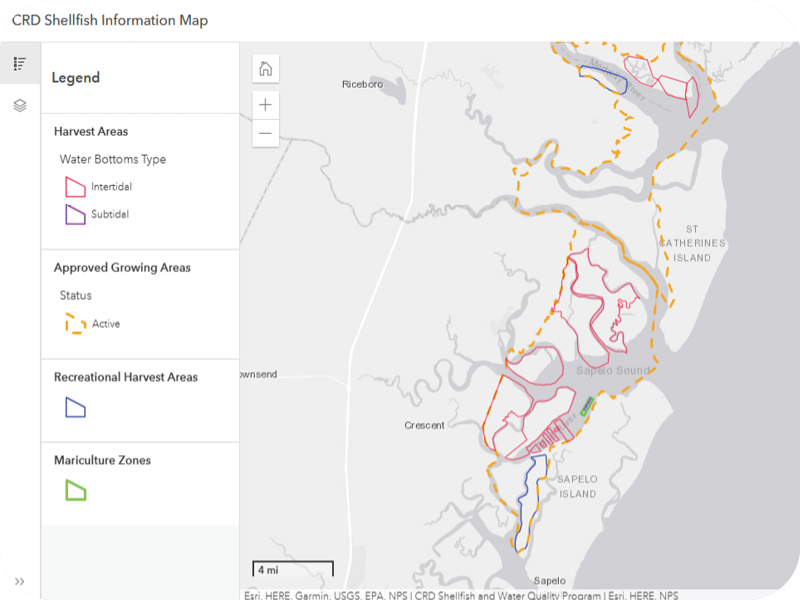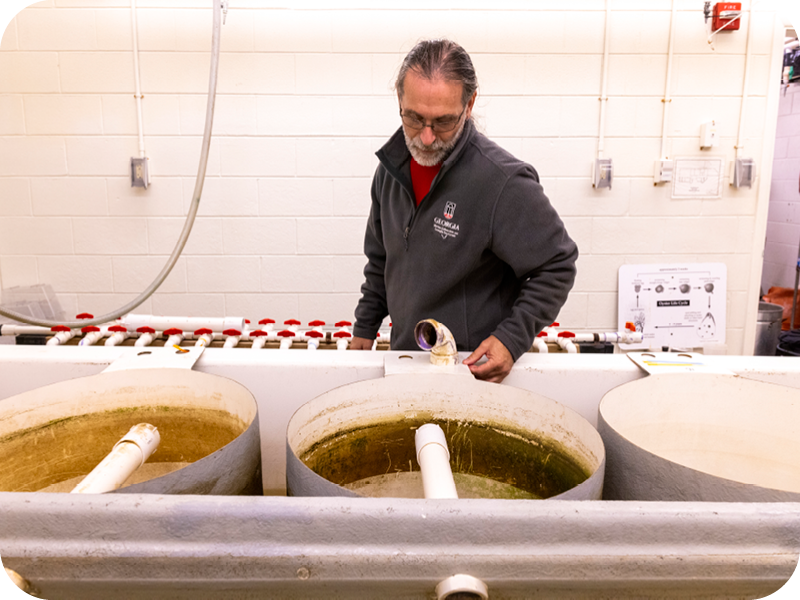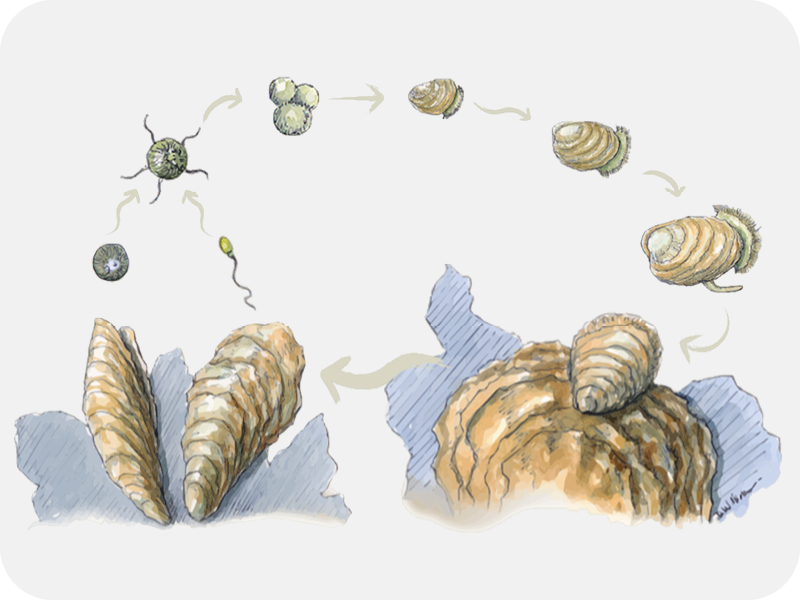
For more than 20 years, the Coastal Resources Division (CRD) has monitored the water quality of Georgia's coastal waters for the safe recreational and commercial harvest of shellfish (oysters and clams). This endeavor is funded by the state of Georgia and consists of water quality monitoring, permitting shellfish harvesters, leasing state shellfish areas, sanitary surveys, and report writing. CRD administers this program under the guidance of the United States Food and Drug Administrations (FDA) National Shellfish Sanitation Program (NSSP) standards. The NSSP Manual of Operations (Part 1, Section C-3,a) requires that states show that shellfish harvest areas are "not subject to contamination from human and/or animal fecal matter in amounts that in the judgment of the State Shellfish Control Authority (SSCA) may present an actual or potential hazard to public health."
The Georgia Department of Natural Resources and the Georgia Department of Agriculture together form the SCCA. Standards of the NSSP require the state to regularly collect water samples from each approved shellfish harvest area and to perform certain analytical procedures to ensure that the area is below the established fecal coliform threshold of 14mpn/100ml. Currently, CRD monitors 82 stations on the Georgia coast, concentrated around shellfish harvest areas, for fecal coliform bacteria. Chatham, Liberty, McIntosh, Glynn, and Camden counties all have shellfish water quality sites in the adjacent water bodies designed to monitor and classify waters for potential shellfish harvest. These stations are monitored once every month at random tide stages.
The recreational harvest of oysters is open
as of 7 a.m., Oct. 1, 2025. Be sure to use approved harvest areas. Find more information here.
Commercial Shellfish Harvest
CRD oversees commercial shellfish harvesting, permits, leases, and water quality monitoring for Eastern Oysters and Hard Clams in designated areas. Find information about general regulations, leasing opportunities, permitting, and more.
Recreational Shellfish Harvest
Recreational shellfish harvesting in Georgia allows individuals to collect oysters and clams from approved areas. Harvesters must follow seasonal regulations, size limits, and permit requirements to ensure sustainability and protect coastal resources.
Shellfish Leasing
Georgia’s shellfish leasing program offers intertidal and subtidal leases for commercial shellfish harvest. The program provides leasing opportunities, regulations, and resources to support sustainable oyster and clam mariculture in coastal waters of Georgia.
Shellfish & Water Quality Program Information

Shellfish Water Quality Lab
In 2016, the Shellfish and Water Quality Unit of the Coastal Resources Division committed to re-establish a laboratory for shellfish analysis at Coastal Regional Headquarters. On April 19-20, 2017, the shellfish laboratory was evaluated by Johnna P. Fay, of the U.S. Food and Drug Administration, for conformity to the standards set forth by the National Shellfish Sanitation Program (NSSP). At the time of the evaluation, the laboratory was not yet actively processing regulatory samples for classified growing areas in Georgia. The evaluation found the laboratory to be provisionally conforming to the NSSP requirements and is currently approved to analyze regulatory compliance samples.

Shellfish Information Map
Find information about shellfish harvest areas, intertidal and subtidal water bottoms, approved growing areas, recreational harvest areas, and commercial mariculture zones in this interactive map.

Georgia's First Oyster Hatchery
Oyster growers are an important part of Georgia's history. In the early 1900's, the state led the nation in oyster production, annually harvesting 8 million pounds of oyster meat, primarily for the canning industry. By the 1940's, the industry was in decline due to over-harvesting and decreasing demand for canned oysters. The last shucking houses in coastal Georgia closed in the 1960's. Harvested oysters now are primarily sold in clumps for private roasts. In 2015, in order to revive the once thriving oyster industry in Georgia, Georgia's first ever oyster hatchery was created through a collaborative effort between the Georgia Department of Natural Resources, the National Oceanic and Atmospheric Administration, the University of Georgia Marine Extension and Sea Grant, the Georgia Department of Agriculture, and the Georgia Shellfish Growers Association. The hatchery, located at the Shellfish Research Lab on Skidaway Island, is growing the oyster aquaculture industry in Georgia by allowing harvesters to farm single oysters that can be sold on the half-shell, a lucrative market fueled by restaurant and consumer demand. With the launch of the hatchery, growers can produce oysters in a faster, more cost-effective way. Researchers at the lab are using established hatchery techniques to produce spat, or baby oysters. When spat reach a certain size, they are delivered to the growers on the coast who take the baby oysters to their shellfish leases for cultivation. Each grower has received 900,000 spat since the start of the hatchery. In addition to providing native spat, researchers at the hatchery share guidance with participating growers, who are trained in handling and transplanting spat and learn new methods for cultivating oysters. Additionally, extension specialists are connecting growers with seafood distribution companies to increase awareness of the Georgia single oyster. In return, growers are sharing their experiences and data with researchers.

Oyster Lifecycle
The entire life cycle of an oyster, from fertilization to settlement, takes place within 14 to 21 days. The spawning process, where oyster sperm and eggs are released into the water column, begins in late March and continues through late September. A fertilized egg transforms through three free-swimming larval stages: the trochophore (within 12-20 hours), the veliger (20-48 hours), and the pediveliger (after 48 hours). The pediveliger larva uses its "foot" to crawl around in search of a hard substrate on which to attach itself to live and grow. As it grows, the larva undergoes a metamorphosis and becomes spat. It will continue to secrete calcium carbonate to develop is shell. In the wild, oyster larvae attach to other adult oysters, creating the jagged, clustered oysters. In the hatchery, oyster larvae are provided with small pieces of oyster shells or other material, called cultch, which help to create single oysters. Oysters grow about two inches per year. However, in Georgia, oysters can reach full maturity in as little as four months and can be commercially harvested when they are two inches long.
Forms & Resources:
Regulations & Policies
Shellfish Policy Manual Version 1.2 (12/2024)
Georgia Code of Regulations
Interstate Shellfish Sanitation Conference
National Shellfish Sanitation Program
United States FDA Certified Shellfish Shippers
GA Dept. of Agriculture Consumer Safety Div.
Permits & Applications
Harvester Permit Application
Shellfish Mariculture Permit Application
Shellfish Importation Application
Intertidal Shellfish Lease Application
Subtidal Shellfish Lease Lottery Application
Leasing & Hatcheries
Shellfish Leasing Dashboard
List of Approved Out-of-State Hatcheries
Monitoring & Surveys
Coastal Resources Shellfish & Water Quality Monitoring
Commercial Shellfish Interest Survey
Guidelines & Forms
Shellfish Harvesters Pamphlet
Cultch Deployment Form
Sign Up to Receive Shellfish Leasing Updates and Opportunities from CRD
Provide your email address below to register for CRD's emailing list.



















